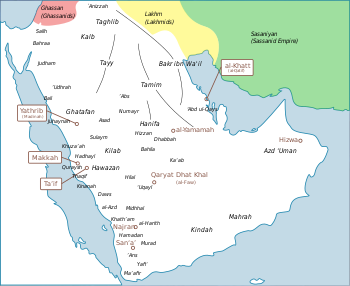अदनान
(अदनानी क़बीले से अनुप्रेषित)
अदनान' (अरबी: عدنان, अंग्रेज़ी: Adnan) पारंपरिक अरब मान्यताओं में अरबी प्रायद्वीप के उत्तरी, मध्य और पश्चिमी भाग के अरब लोगों के सांझे पूर्वज का नाम था। उनके वंशजों को 'अदनानी अरब' कहते हैं। इसके विपरीत क़हतानी उन अरब लोगों को कहा जाता है जिनकी मूल मातृभूमि अरबी प्रायद्वीप का दक्षिणी या दक्षिणपूर्वी भाग, विशेषकर यमन क्षेत्र, है। बहुत से क़हतानी क़बीले अब अपनी पूर्व गृहभूमि से दूर-दराज़ क्षेत्रों में रहते हैं।[1] सभी अरब क़बीलों को 'क़हतानी' या 'अदनानी' में वर्गीकृत किया जा सकता है और इन दोनों शाखाओं में ऐतिहासिक खींचातानी रही है।[2] अरबी लोक-मान्यता में क़हतानी शुरू के मूल अरब थे और अदनानी बाद में अरब बने।[3]
| अदनान | |
|---|---|
 कुछ विशेष अरब क़बीलों के अनुमानित स्थान, जिनमें अदनान के वंशज शामिल हैं, उदा0हाज़िन और क़ुरैश | |
| प्रसिद्धि का कारण | इस्लाम के पैग़म्बर मुहम्मद और अदनानी अरब के सांझे पूर्वज। |
| बच्चे |
मआज बिन अदनान अक्क बिन अदनान |
| माता-पिता | उदद(पिता) |
अदनान से मुहम्मद तक के वंशज
संपादित करेंइस्लामी मान्यता में पैग़म्बर मुहम्मद अदनानी अरब थे और उनके और अदनान के बीच के वंशज इस प्रकार हैं:[4]
- 122 ई० पू० – अदनान (ई० nan, عدنان)
- 89 ई० पू० – मआद (en:Ma'ई० d, معد)
- 56 ई० पू० – निज़ार (Nizar, نزار)
- 23 ई० पू० – मुधर (Mudar, مضر)
- 10 ई० – अलियास (Elias, إلياس)
- 43 ई० – मुद्रिकाह (Mudrikah, مدركة)
- 76 ई० – ख़ुज़ैमाह (Khuzaimah, خزيمة)
- 109 ई० – किनानाह (Kinanah, كنانة)
- 142 ई० – अल-नध्र (al-Nई० r, النضر)
- 175 ई० – मालिक (Malik, مالك)
- 208 ई० – फ़िहर / फ़िह्र (Fihr, فهر)
- 241 ई० – ग़ालिब (Ghalib, غالب)
- 274 ई० – लुवैइ (Luwaiy, لؤي)
- 307 ई० – कआब (Ka'ab, كعب)
- 340 ई० – मुर्राह (Murrah, مرة)
- 373 ई० – किलाब (Kilab, كلاب)
- 406 ई० – क़ुसई (Qusai, قصي)
- 439 ई० – अब्द मनाफ़ (Abd Manaf, عبد مناف)
- 472 ई० – हाशिम (Hashim, هاشم)
- 505 ई० – अब्द अल-मुतल्लिब (Abd al-Muttalib, عبد المطلب)
- 538 ई० – अब्दुल्लाह (Abd Allah, عبد الله)
- 570 ई० – मुहम्मद (en:Muhammई० , محمد)
इन्हें भी देखें
संपादित करेंसन्दर्भ
संपादित करें- ↑ The Middle of the Earth, Allen Austin, pp. 118, Xulon Press, 2011, ISBN 978-1-61215-912-6, ... Arab genealogies usually ascribe the origins of the Qahtanites to the South Arabians who built up one of the oldest centres of civilisation in the Near East beginning around 800 BC ...
- ↑ Journeys in Holy Lands: The Evolution of the Abraham-Ishmael Legends in Islamic Exegesis Archived 2016-05-05 at the वेबैक मशीन, Reuven Firestone, pp. 72, SUNY Press, 1990, ISBN 978-0-7914-0331-0, ... The genealogists agree that all Arab tribes are derived from one of two great ancestors, Qahtan or 'Adnan. The former is generally associated with the True or Original Arabs (al-'arab al-ariba) ...
- ↑ Arabian poetry for English readers, William Alexander Clouston, pp. 21, McLaren and Son (Printer), 1881, ... Those descended from Qahtan are called 'al-Arabu:l-ariba, genuine or pure Arabs (some authors, however, consider the old lost tribes as the only pure Arabs) ; those from 'Adnan, 'al-'Arabu-'l-musta'riba, naturalised or insititious Arabs ...
- ↑ A Dictionary of Islam: Being a Cyclopaedia of the Doctrines, Rites, Ceremonies, and Customs, Together With the Technical and Theological Terms, of the Muhammadan Religion Archived 2012-11-14 at the वेबैक मशीन, Thomas Patrick Hughes, Asian Educational Services, Page 19, 1995 (first published 1885), New Delhi, ISBN 978-81-206-0672-2